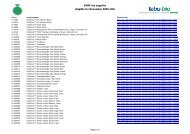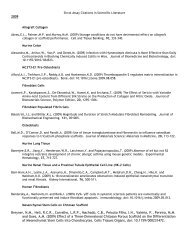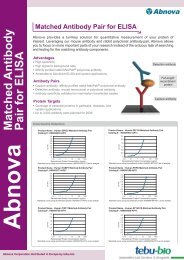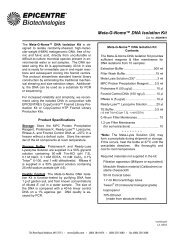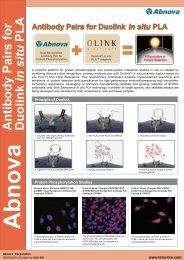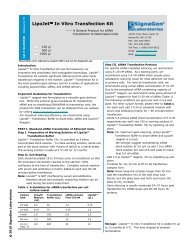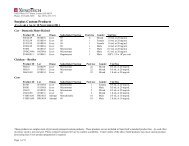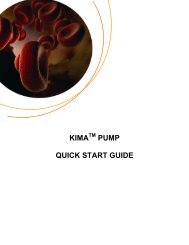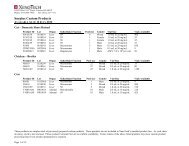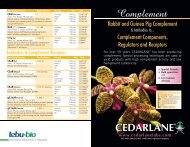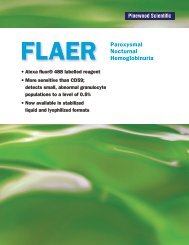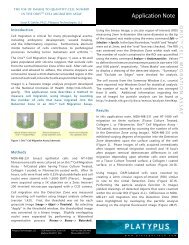Application Note DiUb K63 - tebu-bio
Application Note DiUb K63 - tebu-bio
Application Note DiUb K63 - tebu-bio
Create successful ePaper yourself
Turn your PDF publications into a flip-book with our unique Google optimized e-Paper software.
(e.g. signal gain, plate height reads, etc.) is also<br />
recommended. Any fluorescence or multimode plate reader<br />
capable of the configuration described above should be<br />
suitable for this assay.<br />
SUGGESTED PROTOCOL (96 well plate)<br />
1. Dilute <strong>DiUb</strong> <strong>K63</strong> substrate to 400nM, or 2x the desired<br />
final concentration, in assay buffer of choice (e.g.<br />
50mM Tris, pH 8.0, 0.05% CHAPS, 10mM DTT).<br />
2. Dilute the USP2core to 2X desired final concentration in<br />
buffer of choice. A range of enzyme concentrations,<br />
spanning at least three orders of magnitude, is<br />
recommended.<br />
3. Dispense 50µL of <strong>DiUb</strong> <strong>K63</strong> substrate (or assay buffer<br />
as no enzyme control) into black assay plate wells.<br />
4. Add 50µL of USP2core and read immediately in a preconfigured<br />
fluorescence plate reader (see above) for<br />
30min to 1hour.<br />
Representative Data for <strong>DiUb</strong> panel<br />
Beyond differential linkages (e.g. K48 versus <strong>K63</strong>),<br />
LifeSensors has created subpanels of IQF diubiquitin<br />
substrates within each linkage. Because each DUB is likely<br />
to recognize and cleave substrate with unique steric<br />
considerations, these subpanels vary in location of reporter<br />
fluorophore and quencher. It is recommended that each<br />
DUB be empirically evaluated against the entire panel to<br />
select the fluorophore/quencher combination that provides<br />
the optimal signal:background ratio. Shown below is<br />
representative data from such testing.<br />
Signal:Background<br />
20<br />
15<br />
10<br />
5<br />
0<br />
<strong>DiUb</strong>K48-1<br />
<strong>DiUb</strong>K48-2<br />
<strong>DiUb</strong>K48-3<br />
USP2core<br />
<strong>DiUb</strong><strong>K63</strong>-1<br />
<strong>DiUb</strong><strong>K63</strong>-2<br />
<strong>DiUb</strong><strong>K63</strong>-3<br />
<strong>DiUb</strong><strong>K63</strong>-4<br />
<strong>DiUb</strong>K48-2<br />
AMSHcore<br />
<strong>DiUb</strong>K48-3<br />
<strong>DiUb</strong><strong>K63</strong>-1<br />
<strong>DiUb</strong><strong>K63</strong>-2<br />
<strong>DiUb</strong><strong>K63</strong>-3<br />
<strong>DiUb</strong><strong>K63</strong>-4<br />
LifeSensors, Inc. | 271 Great Valley Parkway | Malvern, PA 19355 |[p] 610.644.8845 | [F]: 610.644.8616 | www.lifesensors.com<br />
http://www.<strong>tebu</strong>-<strong>bio</strong>.com/contacts<br />
Signal:Background<br />
12<br />
10<br />
8<br />
6<br />
4<br />
2<br />
0<br />
100nM enzyme (USP2core and AMSHcore) was incubated for 1 hour with<br />
100nM substrate. Fluorescence was measured and compared with no enzyme<br />
control to determine signal:background. While USP2c exibits less linkage<br />
specificity, it nonetheless prefers certain fluor/quencher location combinations.<br />
AMSHc displays both linkage and location specificity.<br />
REFERENCES<br />
1. Pickart, C.M. and Eddins, M.J. (2004). "Ubiquitin:<br />
structures, functions, mechanisms." Biochim <strong>bio</strong>phys Acta.<br />
1695 (1-3): 55-72.<br />
2. Wilkinson, K. D. (2000). "Ubiquitination and<br />
deubiquitination: targeting of proteins for degradation by the<br />
proteasome." Semin Cell Dev Biol 11(3): 141-8.<br />
3. Ciechanover, A. (2003) "The ubiquitin proteolytic system<br />
and pathogenesis of human diseases: a novel platform for<br />
mechanism-based drug targeting." Biochem Soc Trans<br />
31(2): 474-81.<br />
4. Shahri, R. (2005) “Diverse polyubiquitin interaction<br />
properties of ubiquitin-associated domains.” Nature<br />
Structural & Molecular Biology 12(8): 708-14.<br />
.



